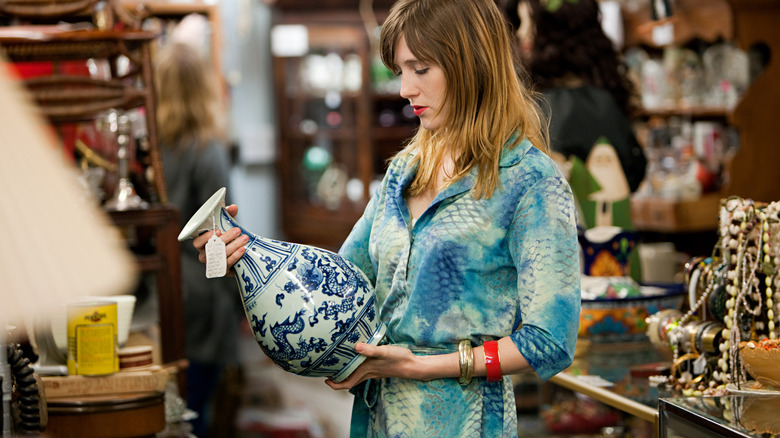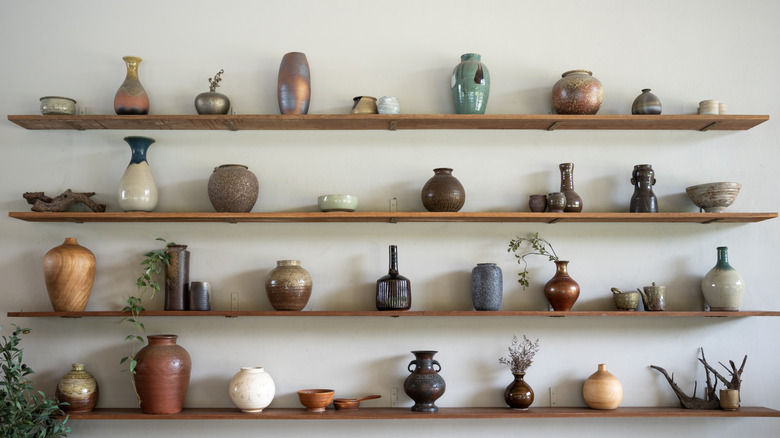The Styling Secrets That Make Thrifted Vintage Ceramics The Centerpiece In Your Home
If you aren't lucky enough to receive a china cupboard full of quirky plates, curious mustache cups, or one-of-a-kind vases from an elderly relative, you can look for such items at your local thrift store. Secondhand shopping is one of the secrets to using vintage ceramics as decor because you're much more likely to find pieces that none of your neighbors have on display than if you purchased brand new items at a local retailer. According to Erika Dale, House Digest's interior design expert and Founder of Erika Dale Interior Design, careful groupings on open shelves, layering special items with artwork, and picking pieces that speak to you on a personal level are the styling secrets that can make thrifted vintage ceramics the centerpiece in your home.
"I absolutely love showcasing vintage and/or handmade ceramics as a design element in a space," Dale told House Digest during an exclusive interview. "The unique charm and visual interest they provide is unmatched, and because of their age and/or hand-crafted qualities, they always appear as though they have a rich story and a sense of history behind them," she explained. Dale added that mass-produced ceramics can make your space look totally generic. She said using thrifted vintage ceramics is a "far more interesting, curated, and layered approach." Handmade, earth-toned, and large-scale finds are the antique decor pieces that should be on your thrifting wishlist in 2025.
The pros and cons of delicate thrifted decor
There are a lot of ways to thrift home decor, from church rummage sales to finding online sellers everywhere from Etsy to eBay. Curating a great collection takes time and patience. Once you've found the perfect pieces, there are some styling tips Erika Dale said you should keep in mind. "I love grouping ceramics in various shapes and sizes together on a bookcase or console to showcase a curated yet quirky assortment of objects," she said in her exclusive exchange with House Digest. But when you've found a special, spectacular, or super-sized piece, she suggested either using open shelving to display it alone or "layering it with artwork and other decor items to feel part of a larger arrangement." Dale recommended not overlooking the opportunity to showcase your largest thrifted vintage ceramics solo, either on a sideboard or console. And, of course, "the mantle is another wonderful opportunity to showcase a pair of smaller vintage ceramics or a larger scale ceramic, like a vase with greenery," she added.
According to Dale, there are also some downsides to decorating with delicate vintage decor, and she cautioned that ceramics are especially breakable. "They are challenging or impossible to replace, which can be heartbreaking if you are attached to it," she said. The interior design expert also explained that it can be very difficult to find matching pairs or multiples of certain vintage items. "You will have to hunt long and hard ... there is rarely an option to just purchase a second if you decide you want to style it that way," she added.
What to look for when thrifting vintage ceramics
Chatting exclusively with House Digest, Erika Dale shared some excellent tips for thrifting the best vintage ceramics. "I personally shop for vintage pieces based on aesthetics, scale, and if they speak to me. Sometimes I have the perfect location in mind, but usually a piece just finds me, I fall in love, and make a space for it in my home or in a client project," she said. Dale added that her approach won't help you determine the actual value or origin of a piece. Instead, she recommended looking at labels to better understand the history or material of the item you're considering, or consulting with an expert especially if you plan to invest in more valuable antiques. (The Google Lens app is an excellent way to quickly find this information when you're on the hunt.)
You should also carefully look over each piece to make sure it's structurally sound. "It is worth inspecting the piece for cracks, chips, and damage because, though it's not always a deal breaker, you will want to be aware of any issues up front," Dale said. If you find a must-have piece with a small flaw, you may be able to negotiate a better price with the seller. Finally, Dale recommended that you also check any vintage tableware for lead before using it, as that potential hazard could easily be hiding in your thrifted collections.


